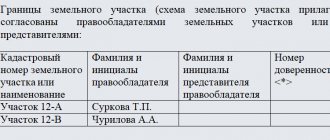Application for the establishment of an easement
Conditions for establishing an easement:
1) the activity for which the easement is established is not prohibited on the land plot encumbered by the easement, which is confirmed by ___________________________________________________________;
2) the activity for which the easement is established will not entail the impossibility of using for a long time (six or more months) the entire land plot encumbered with the easement and the real estate located on it in accordance with the type of permitted use of such a land plot, which is confirmed by __________________________________________ ;
3) the activity for which the easement is established will not entail the impossibility of carrying out for a long time the activities of another holder of the easement, which is confirmed by ___________________________________;
(if necessary: 4) the construction of a structure, including a linear facility, which is supposed to be carried out under the terms of an easement, is provided for by a territory planning project approved in the manner established by the legislation of the Russian Federation and (or) a territory surveying project approved in the manner established by the legislation of the Russian Federation, which is confirmed _________________________________;)
(if the establishment of an easement leads to significant difficulties in the use of the land plot: 5) the owner of the land plot in respect of which the easement is established has the right to demand from the owner of the easement a proportionate payment for its establishment.)
1. Documents confirming the applicant’s status.
2. Documents confirming the need to establish an easement.
3. Schemes of the proposed boundaries of the easement area.
4. A territory planning project and (or) a territory surveying project approved in accordance with the procedure established by the legislation of the Russian Federation (if the specified documentation is available).
5. (If it is necessary to establish an easement for a period of more than five years: a map (plan), agreed upon in accordance with the procedure established by the legislation of the Russian Federation, containing information about the boundaries of the easement zone and prepared in accordance with the data contained in the territory planning project, the territory surveying project , in which the established easements are displayed.)
6. Power of attorney of the representative dated “___”__________ ____ city N ___ (if the application is signed by the applicant’s representative).
7. Other documents confirming the circumstances on which the application is based.
An easement is a limited right to use a site that is owned by someone else. A restriction agreement is possible only on the condition that access to the neighboring plot is impossible under other conditions.
Dear readers! The article talks about typical ways to resolve legal issues, but each case is individual. If you want to find out how to solve your particular problem , contact a consultant:
+7 (Saint Petersburg)
APPLICATIONS AND CALLS ARE ACCEPTED 24/7 and 7 days a week.
It's fast and FREE !
According to the law, it is simple to demand the right to someone else’s land; only sufficient grounds are needed. But in practice, everything turns out to be much more complicated, since the owner of the property may be against encumbering his property. Because of this, a large number of details arise that affect the establishment of an easement.
Central moments
Main reasons
The grounds for establishing an easement are specified in Article No. 39.23 of the Land Code of the Russian Federation. Conditions apply to state or municipal property. In addition, some federal legislative acts and several articles of the Civil Code of the Russian Federation deal with regulation.
Grounds for establishing an easement:
- on the territory it is necessary to place linear objects, special signs, communication structures, protective buildings that are not intended to impede the use of land in their intended direction;
- it is necessary to carry out survey work;
- it is necessary to carry out work on subsoil use.
These grounds are a valid reason for imposing a public or partial easement.
Sample passport of a citizen of the Russian Federation
General concepts and laws
Establishing an easement on a land plot is a procedure for encumbering the territory, which is necessary for the free functioning of land for owners or other users. An easement is necessary only in cases where it is impossible to avoid the procedure.
The installation of an easement is permitted only when the site will be used in the intended direction and beyond. Work on the site must fully comply with legal regulations that are valid at the time of acceptance of the encumbrance.
Site inspection is a mandatory part of establishing a public or private easement. The list of all necessary checks is contained in the relevant legislative acts. An easement is an encumbrance that limits the scope of use of a site.
The procedure is regulated by legislative acts from the Civil Code of the Russian Federation and the Land Code of the Russian Federation. Issues regarding the establishment of a public easement are regulated by regulations from both codes.
The Civil Code determines for what purposes and how an easement is established. The regulatory act also determines the directions for carrying out work if a decision has been made to encumber the site. Contains information on the regulation of issues when establishing a private easement.
The Land Code regulates the establishment of public easements. A normative act specifies the purposes of establishing an encumbrance, the main parameters of the procedure, the procedure for action and the procedure for issuing normative regulatory acts.
Find out here where a land purchase and sale agreement is drawn up.
Administrative regulations and judicial practice
Regulation of the relationship to encumber state or municipal land in 2020 is possible thanks to legislative acts that are defined in the document “Administrative Regulations for Establishing an Easement,” which notes the following points of the regulation:
- procedure for carrying out the encumbrance procedure;
- deadlines, stages of action, which are accompanied by a list of services;
- the procedure for interaction between the local government body and the applicant, which can be a citizen, legal entity, government agencies and organizations;
- procedure for appealing actions of local authorities.
The document helps determine the procedure for concluding an agreement to encumber the site. The basis for regulating the procedure for drawing up a document lies in legislative acts. It is the basis for creating regulations in each subject of the Russian Federation.
If the parties were unable to find a compromise, then if disputes arise, an appeal to the court may be filed. An interested citizen or legal entity must apply and justify their point of view.
Filing a claim for the establishment of an easement on a land plot is possible only against the owner of the territory. As a rule, the main reason for applying is the desire to obtain rights to use someone else’s land, for which the person has every reason, but the authorities deny him this. In addition to rights, it is necessary to provide evidence that the assignment of an easement is the only way out of the current situation with the land.
Important design details
Required documents
Registration of an easement is possible only if there is an agreement in writing. To do this, one of the parties must apply to create an agreement. Transfer of rights to use land is carried out only after entering information into the Register.
In some cases, an easement is established only for a certain part of the site. Then it will be necessary to carry out cadastral work that will help identify the boundaries of the plots.
Required documents:
- statement;
- original and copy of the receipt for payment of the state duty;
- passport if an individual is participating;
- a copy of the administrative act establishing an easement on the plot or its share;
- agreement on the establishment of an encumbrance in two copies, to which all the required additions are attached;
- a copy of the court decision with the judge’s certification, if any;
- original and copy of the cadastral plan.
Procedure for compilation
The establishment and registration of restrictions on rights to a land plot may be possible for various purposes and tasks. Easements are divided into private and public.
A private easement is established according to the following procedure:
- Sending a proposal to the land owner to establish an easement.
- If the property owner has given his consent, then an agreement must be signed. If the owner refuses, the applicant can go to court if he has sufficient grounds to establish a restriction on property rights.
- Registration procedure.
A public easement is established according to the following procedure:
- The interested party submits an application for easement of the plot or its share.
- A decision is made by a state body or local government body to accept or reject the application.
- If permission is given, the application must be supplemented by a cadastral plan of the site.
- If the landowner does not receive a complete list of rights and cannot use the land at his own discretion, then he has the opportunity to buy or seize the plot. To do this, submit a corresponding application, where all information about the claim must be collected.
- If the landowner has problems during the operation of the land, he can count on compensation. To do this, you need to submit a corresponding application with calculation of payments.
- The decision is made within one month.
- Rights are transferred from the moment of registration.
Other nuances
The easement agreement being drawn up allows the applicant to use the land subject to certain conditions. The applicant will be able to use the land for passage or passage, or for other routes.
The document being drawn up must contain information about the site, parties to the agreement and a land plan, which is necessary to clearly demonstrate the road or trail that will be used for movement.
Payment for the use of the site is not a mandatory item; transactions are often concluded free of charge. The contract may have a validity period, if one is specified, otherwise the agreement will be valid for life.
How to draw up an agreement
Before an easement agreement is drawn up, the interested party must notify the owner of the land of his proposal. The form of the document is written. To do this, a notice is drawn up indicating the purpose and grounds for using the site. They must comply with legal requirements.
And only after the owner agrees to the transaction, an agreement on easement of the land plot is concluded, a sample of which is freely available. The document is drawn up very simply and does not need to be certified by a notary. The main thing is that the contract contains all the necessary essential conditions:
- Information about the parties who enter into the agreement.
- Information about the site that is the object of a private easement.
- Reasons for entering into a deal.
- Reasons confirming the absence of other ways to solve the problem.
- Duration of validity of a private easement.
- The amount of the fee if the encumbrance is compensated.
- The procedure and amount of compensation in case of damage.
The document must list the ways in which the allotment can be used. This is indicated, for example, as “the exercise of the easement by the user occurs in the following order,” and then there is a description of the necessary actions of the person interested in the easement.
To draw up an easement agreement for a land plot, you will need a sample and form. They can be obtained from lawyers. Most often, an agreement to establish a private easement on a land plot leads to disputes between the parties regarding the fee for limiting the rights of the owner. Some owners demand too much money, which is why the law contains the wording “proportionate amount”.
Other publications: Fine nets for front windows
If disputes about the amount of money when concluding an easement agreement drag on, you can call an expert . He will fix the value of the land and its use, taking into account the purpose of the limitation. It is not recommended to file a claim in this situation, since the court will make a similar decision.
Restriction of rights can also be obtained for a plot that is owned by several persons. The difference in registration depends on whether the shares were allocated earlier or the land was not divided. If the owners have allocated their parts, then the contract is concluded with only one, and the rest are required to give their consent to the restriction. In the opposite situation, the initiator of the easement is obliged to draw up an agreement with all co-owners of the land.
Difficulties and other features
Like any other legally significant action, the establishment of an easement has its own difficulties and characteristics. They apply not only to the applicant, but also to the owner of the land.
Difficulties are divided into two groups:
| Difficulty in establishing | This group includes difficulties that depend on the formation of encumbrance rights and the conclusion of an agreement between the parties. |
The group includes the following problems:
- the parties cannot come to an agreement because one of the parties does not agree with the terms;
- inappropriate valuation.
These problems can only be resolved through litigation. The initiating person is the applicant who wishes to establish an easement on the land plot.
If the issue of overvaluation is resolved, the court may order a panel for an independent assessment. The results obtained should form the basis for determining the cost, which will be reflected in the contract with the annex of an independent assessment.
- the paperwork was completed incorrectly or an incomplete package of papers was provided;
- requirements for registration of an easement are not legal (in this case, a detailed check is carried out, which should establish the facts and reasons for filing the application).
In order for registration to be confirmed, agreement between the parties and a complete list of documents is necessary. Without this, it is impossible to register an encumbrance on the site.
Reasons for termination
Termination of an easement is possible if the following reasons exist: the land plot cannot be used for its intended purpose or the obligations that caused the encumbrance imposed on the plot are terminated.
The first ground can only be used when going to court. The second is determined in the appropriate paragraph when concluding the agreement.
What you need to know when buying a plot in SNT - read this article.
We will tell you further where to start privatizing a land plot.
- Due to frequent changes in legislation, information sometimes becomes outdated faster than we can update it on the website.
- All cases are very individual and depend on many factors. Basic information does not guarantee a solution to your specific problems.
That's why FREE expert consultants work for you around the clock!
- via the form (below), or via online chat
- Call the hotline:
- Moscow and the Region
- St. Petersburg and region
- Regions
When is it necessary to file a claim to establish an easement?
The procedure for establishing a private easement involves two possible scenarios. The first option is based on the voluntary consent of citizens and implies the following actions:
- Before registering a private easement, the owner of a land plot or building interested in its creation must contact the owner of the plot with a written proposal to grant the right to limited use of his territory.
In the petition, the interested person sets out in detail the grounds for concluding the upcoming agreement and confirms his right with regulatory legislative acts. The application is accompanied by a plan of the part of the land plot to which the encumbrance will be applied and a draft of the future agreement.
| Difficulties with registration | The second group includes the following difficulties: |
- Upon reaching agreement, the parties enter into the necessary agreement. The agreement between the owner and the user provides for the following clauses:
- information about the parties entering into the agreement;
- the subject of the agreement (part of the territory), indicating the grounds for concluding the agreement provided by law, the address and cadastral number of the site;
- indication of the size, location of the site, type of work performed;
- terms of use of land territory;
- the person bearing all costs associated with encumbering the site;
- the procedure for limited use of land;
- rights and obligations of the parties;
- final terms;
- payment for easement indicating the amount of payments;
- procedure for concluding disputes;
- force majeure;
- addresses and details of the parties.
- A properly drawn up agreement is subject to state registration in Rosreestr. Registration requires the provision of the following documents:
- statement from the interested party;
- passports of citizens who signed the application (copies of passports);
- agreement signed by the parties;
- a photocopy of the receipt for payment of the state fee;
- a certified copy of the court order (when going to court);
- cadastral passport, plot diagram (as well as copies of these documents).
Important! The form of the agreement is very important for concluding a transaction; if the agreement is not drawn up properly, the court may invalidate the transaction. Before concluding an agreement, it is necessary to purchase legally executed forms of the agreement concluded between citizens.
Interested parties have the legal right to obtain limited access to someone else's territory if it is impossible to realize their needs and interests in any other way. For example, if a citizen is unable to drive to his plot without crossing the land of a neighbor, he has the right to invite him to enter into an agreement to establish an easement.
At the same time, the resulting restriction should not cause significant inconvenience to the actual owner of the encumbered land. Otherwise, the establishment of an easement is unacceptable.
In addition, the owner of the plot is able to demand a certain payment for the use of his territory if we are talking about damage by the owner of the easement or causing them any inconvenience.
If it is not possible to agree peacefully on the assignment of an easement, the only way out of the situation is to go to court.
For this purpose, lawyers advise sending by registered mail a proposal to establish an easement to the owner of the site to which the interested party requires access.
Application for the establishment of an easement
___________________________________________ (name of executive authority) address: ____________________________________ from _________________________________________ (full name or name of the interested person) address: ___________________________________, telephone: _______________, fax: __________, email address: __________________
Application for the establishment of an easement
For the reason ____________________________________________________________ ________________________________ is interested in establishing an easement (full name or name of the interested person) in the form of _________________________________, within the boundaries of ____________________, for a period of __________ on a land plot of ________ square.
m at the address: ___________________________________, cadastral number: __________________, belonging to the category ___________________________________________ lands, the owner of which is __________________________________________, (full name or name of the interested person), which is confirmed by ______________________. Conditions for establishing an easement: 1) the activity for which the easement is established is not prohibited on the land plot encumbered by the easement, which is confirmed by ___________________________________________________________;
2) the activity for which the easement is established will not entail the impossibility of using for a long time (six or more months) the entire land plot encumbered with the easement and the real estate located on it in accordance with the type of permitted use of such a land plot, which is confirmed by __________________________________________ ;
3) the activity for which the easement is established will not entail the impossibility of carrying out for a long time the activities of another holder of the easement, which is confirmed by ___________________________________;
(if necessary: 4) the construction of a structure, including a linear facility, which is supposed to be carried out under the terms of an easement, is provided for by a territory planning project approved in the manner established by the legislation of the Russian Federation and (or) a territory surveying project approved in the manner established by the legislation of the Russian Federation, which is confirmed _________________________________;)
(if the establishment of an easement leads to significant difficulties in the use of the land plot: 5) the owner of the land plot in respect of which the easement is established has the right to demand from the owner of the easement a proportionate payment for its establishment.)
Based on the above and guided by Part 1 of Art. 17 of the Federal Law of 04/05/2013 N 43-FZ “On the peculiarities of regulating certain legal relations in connection with the annexation of territories to a subject of the Russian Federation - the federal city of Moscow and on amendments to certain legislative acts of the Russian Federation”, ________________________________________________ asks to establish an easement (F. I.O. or name of the interested party) for a land plot at the address: __________________________________________, with cadastral number __________, for a period of __________ on the following conditions: __________________________________________________________________________.
Applications:
1. Documents confirming the applicant’s status.
2. Documents confirming the need to establish an easement.
3. Schemes of the proposed boundaries of the easement area.
4. A territory planning project and (or) a territory surveying project approved in accordance with the procedure established by the legislation of the Russian Federation (if the specified documentation is available).
5. (If it is necessary to establish an easement for a period of more than five years: a map (plan), agreed upon in accordance with the procedure established by the legislation of the Russian Federation, containing information about the boundaries of the easement zone and prepared in accordance with the data contained in the territory planning project, the territory surveying project , in which the established easements are displayed.)
6. Power of attorney of the representative dated “___”__________ ____ city N ___ (if the application is signed by the applicant’s representative).
7. Other documents confirming the circumstances on which the application is based.
“___”________ ____ city ___________________ (signature)
Video on the topic
The claim is filed at the location of the land plot. The claim for the easement must contain evidence of the impossibility of access to the land in any other way, and the claim for the easement must contain the plaintiff’s proposals on how to evaluate the easement.
In the _______________ district (city) court of the ______________ region (region, republic) Plaintiff: ___________________________________ (last name, initials) address: ___________________________________, telephone: ___________, E-mail _____________. Respondent: _________________________________ (surname, initials or name) address: ___________________________________, telephone: _____________, E-mail ___________.
STATEMENT OF CLAIM for the establishment of a limited right to use a land plot (easement) In accordance with _______________________________________________________ (specify the grounds) dated “___”_________ ____, N ________, I am the owner (owner under the right of lifelong inheritable possession or the right of permanent (perpetual) use, another person in cases provided for by federal laws) real estate land plot (other real estate) with an area of __________ square meters.
m, cadastral number __________, at the address: _________________. The defendant is the owner of a neighboring plot of land with an area of __________ square meters. m, cadastral number __________, at the address: ________________ __________________________________________________________________________. "___"_______ ____ G.
I turned to the defendant with a demand to grant me a permanent right to limited use of a neighboring plot (easement) to ensure passage and travel through his land plot (laying and operating power lines, communications and pipelines, ensuring water supply and land reclamation, as well as other needs that are not can be provided without establishing an easement) on the terms of ______________________________ in the amount of __________________________________.
We have not reached an agreement on establishing the terms of the easement. The defendant did not voluntarily satisfy my demand, which is confirmed by: ___________________________________________________________ (circumstances, evidence) (or did not answer me). Based on Article 274 of the Civil Code of the Russian Federation, guided by Articles 131 - 132 of the Civil Procedure Code of the Russian Federation, I ASK: to establish for me a permanent right of limited use of the neighboring plot (easement), cadastral number _________, at the address: _____________ _________________, owned by the defendant, to ensure passage and travel through his land plot (laying and operating power lines, communications and pipelines, ensuring water supply and land reclamation, as well as other needs that cannot be provided without the establishment of an easement) on the terms of ________________________ in the amount of ______________________________.
Attachments: 1. Copy of __________________ on the right of ownership (possession) of a land plot dated “____”___________ _____ with attachments. 2. Receipt for payment of state duty. 3. A copy of the statement of claim for the defendant. 4. Cadastral passport of the plot indicating the scope of the easement. 5. Other written evidence: ________________________. _____________________ (signature) “____”__________ _____ Mr. Kabanov O.M.
Filing a claim
An easement is a complex civil legal relationship, so it is best to entrust the preparation of a claim to a lawyer specializing in land and cadastral law.
Of course, you can try to file a claim yourself, but you should be prepared for the fact that the court will notice shortcomings in the statement of claim and its evidentiary basis and refuse to accept it or return the claim for revision.
To reduce the chances of your claim being rejected, we recommend using the standard template for statements of claim of the type in question available on the website. However, we warn you that there is no standard template that can take into account the entire range of legal relations related to easements.
Read more: When should you check out of an apartment when selling?
When drawing up an application, we recommend that you adhere to the following scheme:
- “cap” of the claim, that is, the name of the judicial body to which the claim is sent, and the full name of the plaintiff and defendant with their addresses;
- the descriptive part of the claim, which includes information about the real estate of the plaintiff and the defendant, information about the reasons that make the easement necessary. It should also be noted that the attempt to conclude an agreement on a voluntary basis was unsuccessful;
- a motivational part in which the easement requirements should be substantiated. First of all, the motivation part must contain information about the impossibility of doing without the establishment of an easement;
- the operative (petition) part, in which a request for the establishment of an easement is stated in a concise form, indicating the owner of the object on which the encumbrance will be imposed and the address of the object:
- a list of applications, that is, documentary evidence of the need for an easement;
- signature of the plaintiff and date of filing the application with the court.
The following must be attached to the claim:
- documents indicating that the plaintiff has ownership rights to the object requiring access through an easement or the right of perpetual use;
- documents confirming the claims - an extract from the real estate register, a cadastral and appraisal report, etc.;
- confirmation of the impossibility of reaching a peaceful agreement on the easement. A copy of the letter containing the proposal may be attached;
- receipt of payment of state duty in the amount of 300 rubles;
- a copy of the plaintiff's passport.
The concept and legislative basis for establishing an easement in relation to a land plot
The initiative to establish an easement belongs to the owners who own a plot of land or a permanently constructed building, who cannot do without the use of neighboring territory in solving important life support issues.
Such owners have a great interest in achieving the intended goal, and act as the main initiators of the procedure for establishing a private land easement.
Based on the legislative acts of the Russian Federation, easements can be established for various periods and purposes, which are specified in the agreement. According to the mutual agreement between the parties, a land easement involves registration on:
- Urgent term. The contract is drawn up for a certain period of time, which is required for construction, equipment of an access road, and transportation of property. After completion of the work, the owner’s right to use someone else’s territory is removed.
- Constant term. When concluding such an agreement, no time period is established. The owner's limited right to use the encumbered plot remains and cannot be terminated until the existing grounds for this cease.
The establishment of an easement is the possibility of limited use of someone else's real estate (land, other real estate).
- The process of establishing easements is regulated by the laws of the Land Code, as well as the Civil Code of Russia, which indicate the procedure for drawing up legislative acts, stipulate the features of the procedure, and determine the grounds and reasons for concluding agreements between the two parties.
- There are grounds for starting any legislative action. When registering easements, the reasons for their establishment are listed in Article 23 of the Land Code of the Russian Federation, as well as in Article 274 of the Civil Code of the Russian Federation. The articles contain a complete list of grounds that citizens need to know in order to begin the procedure for establishing an easement.
- The procedure for the legislative process will be regulated by Article 39.26 of the Land Code of the Russian Federation; it stipulates the deadlines for the authorities to fulfill their powers after the interested party submits an application and obliges the authorized body to fulfill the requirements of the procedure.
- Article 39.25 of the Land Code of the Russian Federation contains requirements for the clauses of the agreement concluded between the parties, stipulates and regulates the procedure for payment provided for in the agreement.
- Article 39.24 of the Land Code of the Russian Federation draws attention to some features when concluding an agreement, regulating the terms for concluding agreements for the establishment of easements.
The owner of the land or the person holding the right of permanent use is capable of demanding the establishment of an encumbrance in the form of a private easement. If a citizen is a tenant, he most likely will not be able to gain access to neighboring land.
A claim for the establishment of an easement on a land plot is filed:
Statement of claim for the establishment of an easement sample and drafting example
In ___________________________________ (name of the court) _____________________________________ Plaintiff: _______________________________ (full name) _____________________________________ (place of residence and registration) _____________________________________ Price of the claim: ___________________________ (amount in rubles)
Statement of claim for the establishment of an easement
“___” __________ _____ on the basis of ________________________________________ The plaintiff acquired a land plot with a total area of _______ sq. m. m, location address ________________________________________________________________________________ cadastral number _________________________________, which is confirmed by the cadastral plan of the land plot No. ___________ dated “___” __________ _____, issued by _____________________________________, land category ________________________________________.
The plaintiff registered his right with _____________________________________________________ (rights registration authority) in accordance with _______________________________________________ (document confirming the fact of registration) dated “___” __________ _____.
The following property of the Defendant ___________________________________________________ (full name) is located on the land plot: ________________________________________________________________________________________________ ________________________________________________________________________________________________. (specify property)
The location of the said property on the Claimant's land plot makes it difficult for the latter to use the plot.
“___” __________ _____ The Plaintiff sent a letter to the Defendant demanding an agreement to establish an easement or vacate the land plot. Until the moment when this statement of claim was sent to the court, the Defendant had not fulfilled this. The Defendant refuses to sign the agreement and does not release the plot.
At the same time, the Plaintiff considers it possible to determine the limited use of the land plot owned by the Defendant for a proportionate fee, which does not contradict the requirements of Art. 23 of the Land Code of the Russian Federation.
Based on the above, guided by art. 23 of the Land Code of the Russian Federation, please:
Establish an easement in relation to a land plot with a total area of _______ square meters. m, location address ________________________________________________________________________________________________ cadastral number________________________________ category of land _________________________________ for a period of ________________________, for a fee of ___________ (_____________________________________________) rub.
Applications:
1. Documents confirming the circumstances set out in this statement of claim. 2. Receipt for payment of state duty. 3. A copy of the statement of claim for the Defendant.
Date of application: “___”_________ ____
Plaintiff's signature ______________
The owner’s disagreement about the imposition of these obligations on his land
Cases of land owners disagreeing with the partial use of their territory by a neighbor are common. On the one hand, the interested party wants to lay out a road or route for communications along the shortest path, which would allow him to avoid unnecessary costs and save time. But in such a favorable direction there is a land plot of a neighbor who does not give consent to the establishment of an easement.
The owner of the plot of land on which the encumbrance is supposed to be imposed may not provide his consent and file a counterclaim against the granting of a private easement to the interested party. The court must take into account the arguments provided by both sides and the arguments that guide citizens, examine the possibilities and only then make its decision.
Establishing a private easement is not a very pleasant procedure for the owners of neighboring plots. It’s good if the matter is resolved voluntarily and relations between neighbors do not deteriorate. The material interest of the owner of the encumbered plot often plays a decisive role in making a legislative decision.
A claim may be sent to the court to establish a public or private easement. In the first case, the purpose of the encumbrance is to meet the needs of the people or authorities.
The second type of easement is aimed at satisfying the personal interests of a particular person. The text of the claim in both cases is practically the same.
A typical statement of claim must contain the following information:
- Full name or name of the applicant, his registration address;
- the exact location of the area to which access is required;
- Full name or name of the land owner;
- the purpose of establishing the encumbrance;
- conditions for using the site;
- date of application;
- a request to establish an encumbrance;
- personal signature of the applicant.
As a rule, to establish a public easement, interested parties apply to the local administration or government agency. After considering the application, the relevant authority issues an act on registration of the encumbrance or sends the applicant a written refusal explaining the reasons for this decision.
If an interested person disagrees with the decision of the authorized body, he has the right to file a claim in court to establish a public easement, the text of which differs little from the structure described above. The introduction of an encumbrance is allowed taking into account public hearings.
How to establish a public easement on a land plot
In order to legitimize a public easement, follow the following procedure.
Submit an application for the need to allocate an easement to the authorized body
According to the requirements of the law, the initiators of encumbrances on land can be government bodies (federal, regional and municipal), as well as citizens and legal entities.
Submit an appeal to the government agency that has jurisdiction over the area you are interested in. For example, if you have the intention to create an easement on lands located in a municipality (village, urban settlement, village, etc.), then submit an application to the local administration.
How to register a private easement on a plot of land?
Read what a public easement on land means here.
In the application for the establishment of an easement, indicate:
- the location of the land plot on which the easement is supposed to be established;
- for what purposes did it become necessary to establish encumbrances;
- information about the owner of the site;
- the circle of persons in respect of whom it is intended to establish an easement.
In the event of a positive decision on the issue of establishing encumbrances on the plot in the interests of an indefinite number of persons, the regulatory act of the authorized body indicates the period during which the right to use the plot will be granted. The law does not provide for clearly regulated deadlines in these circumstances.
Hold public hearings
Public hearings are appointed to make decisions on issues that are vital to a large number of people.
The result of the public hearing (general decision) is documented in a protocol. Its contents indicate a list of issues on which a group of citizens was assembled, the presence of a quorum and the final decision.
Other publications: Statement of claim for refusal to privatize an apartment
An agreement to encumber a land plot for public purposes can be formalized by an agreement between the owner of the property and the persons applying for an easement. The legislation also provides for the possibility of granting an easement based on the contents of the owner’s will (the owner indicated the need to grant an easement to a certain group of persons or a government body).
In some cases, when the participants in legal relations on the need to establish restrictions on land have not come to an agreement, and the authorized body is delaying the decision-making process, contact the judicial authorities.
Submit a document, the content of which confirms the right to the possibility of using someone else's territory (a will, a judicial act, a protocol on public hearings, an agreement between parties to a transaction), to the authorized body for the purpose of issuing an official regulatory act on the establishment of an easement.
The order of the state body on the allocation of a public easement indicates the location of the land plot, the boundaries of the established encumbrance (if the easement is established only in part of the land plot), information about the owner of the plot, the period of time (if the easement is of an urgent nature) and the intended use of the land.
To complete the procedure for legitimizing the easement (amending the Unified State Register), provide the following documents:
- request for registration;
- receipt of payment of the established amount of state duty;
- act of the authorized body on the establishment of an easement;
- cadastral plan of land plot;
- a notarized power of attorney from a representative of citizens interested in establishing an easement.
Documents supplementing the claim
The statement of claim must be supplemented with certain documents:
- a receipt confirming payment of the fee for filing a claim, the amount of which is 300 rubles;
- a copy of the applicant's passport;
- power of attorney (if necessary);
- title papers for a plot located next to neighboring land to which access is required (for example, when establishing a private easement);
- written evidence of contacting the owner of the territory to which the applicant needs access;
- documentation capable of confirming the validity of the encumbrance.
The claim with supporting documents is sent to the arbitration or district court at the location of the site.








